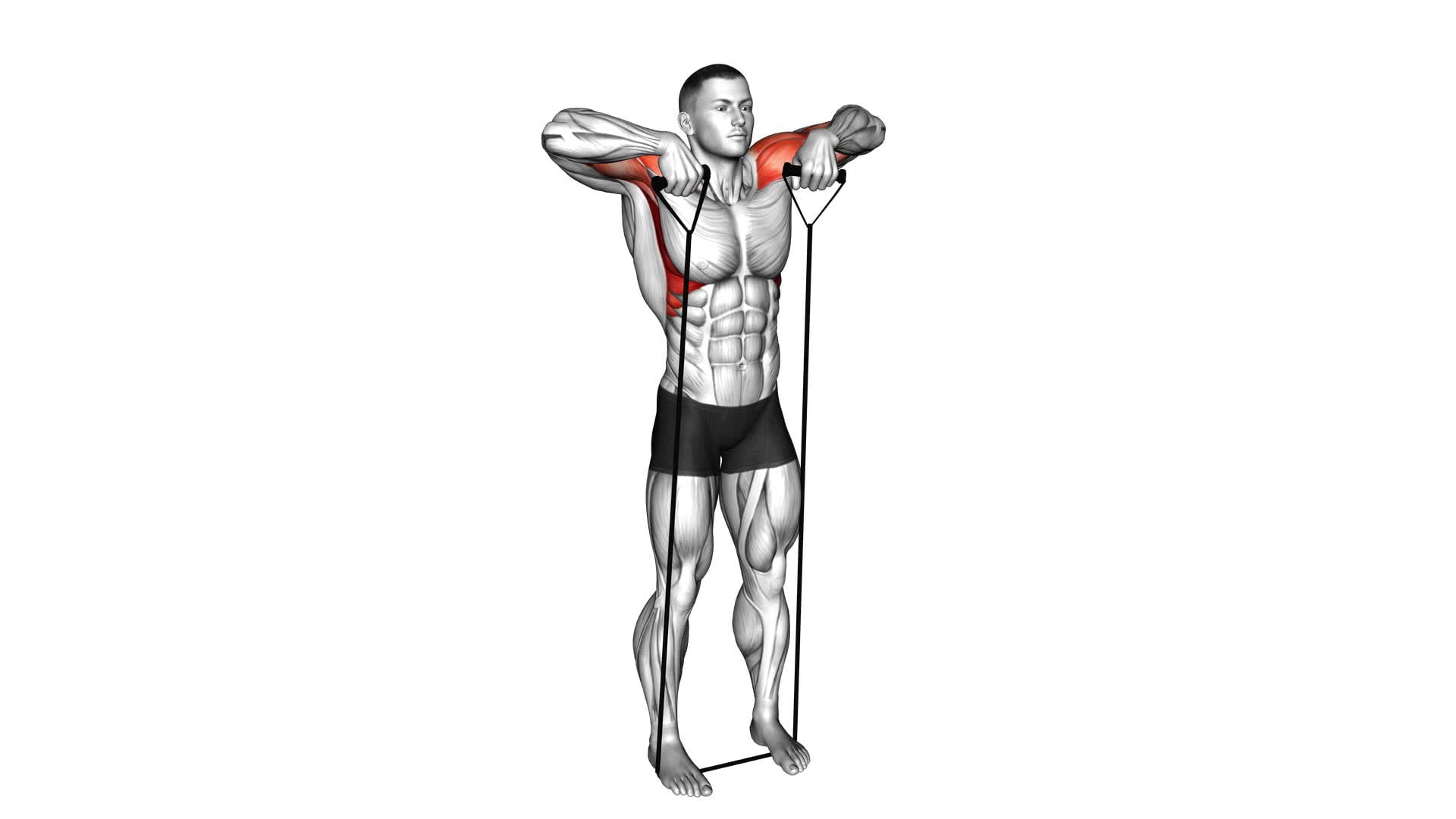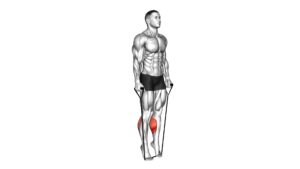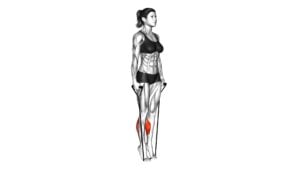Band Upright Row (Under Two Feet) – Video Exercise Guide & Tips

Are you looking for a quick and effective exercise to strengthen your upper body? Look no further than the band upright row!
Watch This Exercise Video
In this video exercise guide, we'll show you how to properly perform the band upright row under two feet, along with helpful tips to maximize your results.
Get ready to tone your shoulders, back, and arms with this simple yet powerful exercise. Let's get started!
Key Takeaways
- Band upright row increases shoulder and upper back strength.
- It is highly effective for muscle activation and shoulder stability.
- The exercise targets deltoids, trapezius, and rhomboid muscles.
- It improves overall posture and reduces the risk of shoulder injuries.
Benefits of the Band Upright Row
You can experience increased shoulder and upper back strength by performing the Band Upright Row exercise. This exercise is highly effective for muscle activation and shoulder stability.
As you perform the Band Upright Row, the muscles in your shoulders and upper back are activated, helping to strengthen and tone these areas. The movement involves pulling the resistance band upward, mimicking the motion of a traditional upright row with weights.
This exercise targets the deltoids, trapezius, and rhomboid muscles, helping to improve shoulder stability. By engaging these muscles, you can enhance your overall posture and reduce the risk of shoulder injuries.
The Band Upright Row is a practical and convenient exercise that can be done anywhere with a resistance band. It's a great addition to your upper body workout routine, as it specifically targets the shoulders and upper back.
Incorporate this exercise into your fitness regimen to experience improved shoulder and upper back strength, muscle activation, and enhanced shoulder stability.
Proper Equipment and Set-Up
To properly set up for the Band Upright Row exercise, gather the necessary equipment and ensure a secure and stable position. Equipment selection is crucial for this exercise to ensure proper form and maximize its benefits.
First, you'll need a resistance band with appropriate tension. Choose a band that provides enough resistance to challenge your muscles, but not so much that it compromises your form. Additionally, make sure the band is securely anchored to a stable object, such as a sturdy pole or door frame. This will prevent any unnecessary movement or accidents during the exercise.
Next, position yourself with your feet hip-width apart and knees slightly bent. Hold the band with an overhand grip, palms facing towards your body, and hands shoulder-width apart. Maintain a straight back and engage your core muscles throughout the exercise.
Step-by-Step Guide for Performing the Exercise
To perform the Band Upright Row exercise, begin by gripping the resistance band with an overhand grip and your palms facing towards your body. Keep your feet shoulder-width apart and your knees slightly bent. Now, let's get into the step-by-step guide to performing the exercise:
- Start with the resistance band hanging in front of your thighs, with your arms fully extended.
- Engage your core and squeeze your shoulder blades together as you pull the resistance band up towards your chest, keeping your elbows pointing out to the sides.
- Pause for a moment at the top of the movement, ensuring that your elbows are higher than your forearms.
- Slowly lower the resistance band back down to the starting position, maintaining control and tension in your muscles throughout the entire exercise.
Muscles targeted during the band upright row:
- Deltoids: The main muscle group worked during this exercise, responsible for lifting your arms.
- Trapezius: These muscles in your upper back and neck help stabilize and control the movement.
- Biceps brachii: Located in the front of your upper arm, these muscles assist in pulling the resistance band towards your body.
Modifications and variations of the exercise:
- You can perform the band upright row with a wider or narrower grip to target different areas of your shoulders.
- If you don't have a resistance band, you can use dumbbells or a barbell instead.
Now that you know how to perform the Band Upright Row, give it a try and feel the burn in your shoulders and upper back!
Common Mistakes to Avoid
One common mistake to avoid when performing the Band Upright Row exercise is failing to engage your core and squeeze your shoulder blades together throughout the movement. Proper form and technique are essential for maximizing the benefits of this exercise and preventing injury.
To ensure proper form, start by standing with your feet hip-width apart and the band securely anchored under your feet. Hold the band with an overhand grip, palms facing your body. As you lift the band towards your chin, make sure to keep your core engaged and your shoulder blades squeezed together. This will help maintain stability and prevent excessive strain on your shoulders and neck.
Another mistake to avoid is using too much weight or resistance. It's important to choose a band or weight that allows you to maintain proper form throughout the exercise. If you're a beginner, start with a lighter band or weight and gradually increase the resistance as your strength improves.
On the other hand, if you're more advanced, you can modify the exercise by using a wider grip on the band or a heavier weight. This will challenge your muscles in different ways and allow for continued progress.
Tips for Maximizing Results
To maximize your results and get the most out of the Band Upright Row exercise, focus on maintaining proper form and technique throughout the movement. Here are some tips to help you achieve optimal results:
- Incorporate alternative variations: Don't be afraid to switch things up and try different variations of the Band Upright Row. For example, you can use different hand grips or vary the width of your grip to target different muscle groups.
- Incorporate resistance bands: Adding resistance bands to your Band Upright Row can increase the intensity and make the exercise more challenging. This can lead to greater muscle activation and better results.
- Focus on the mind-muscle connection: Instead of just going through the motions, concentrate on engaging the targeted muscles throughout the exercise. Visualize the muscles working and contracting as you perform each repetition.
- Gradually increase resistance: As you get stronger, gradually increase the resistance of the band or the weight you're using. This progressive overload will help stimulate muscle growth and improve your overall strength.
Frequently Asked Questions
How Many Repetitions Should I Do for the Band Upright Row Exercise?
To determine the repetition range for the band upright row exercise, it's important to consider your fitness goals and current fitness level. Generally, a good starting point is to perform 8 to 12 repetitions per set.
However, it's crucial to maintain proper form throughout the exercise to avoid injury and maximize effectiveness. Remember to engage your core, keep your back straight, and pull the band towards your chin, leading with your elbows.
Can I Use Any Type of Resistance Band for This Exercise?
Yes, you can use any type of resistance band for the band upright row exercise. Using a resistance band adds extra resistance to your workout, helping to strengthen your upper back, shoulders, and arms.
Different types of resistance bands offer varying levels of resistance, allowing you to adjust the difficulty of the exercise. This gives you the flexibility to progress and challenge yourself as you get stronger.
Is the Band Upright Row Suitable for People With Shoulder Injuries?
Should people with shoulder injuries avoid the band upright row exercise?
If you have shoulder injuries, it's important to consult with a healthcare professional before attempting this exercise. They'll be able to determine if it's safe for you and provide alternative exercises if needed.
Is it necessary to use a resistance band for the band upright row exercise?
Yes, using a resistance band is necessary for performing the band upright row exercise.
The band upright row is a shoulder exercise that involves pulling a resistance band towards your body.
Can I Perform the Band Upright Row Exercise Without a Resistance Band?
Yes, you can perform the band upright row exercise without a resistance band. There are alternatives you can try, such as using dumbbells or a barbell.
The benefits of the upright row exercise include targeting the muscles in your shoulders, upper back, and arms. It can help improve your posture and increase upper body strength.
Remember to use proper form and start with a weight that's appropriate for your fitness level.
Are There Any Alternative Exercises That Target Similar Muscle Groups as the Band Upright Row?
Looking for alternative exercises that target similar muscle groups as the band upright row?
There are a few options you can try.
One is the dumbbell upright row, which works the same muscles but uses dumbbells instead of resistance bands.
Another option is the barbell upright row, which also targets the same muscles but with a barbell.
Both of these exercises can help you build strength and improve your posture.
Don't forget the benefits of using resistance bands, like increasing muscle activation and providing variable resistance.
Conclusion
In conclusion, the band upright row is an effective exercise for targeting the upper back and shoulders.
By using a resistance band, you can increase the intensity and challenge your muscles in a safe and controlled manner.
Remember to maintain proper form and avoid common mistakes to maximize your results.
Incorporate this exercise into your routine for improved strength and posture.

Author
Years ago, the spark of my life’s passion ignited in my mind the moment I stepped into the local gym for the first time. The inaugural bead of perspiration, the initial endeavor, the very first surge of endorphins, and a sense of pride that washed over me post-workout marked the beginning of my deep-seated interest in strength sports, fitness, and sports nutrition. This very curiosity blossomed rapidly into a profound fascination, propelling me to earn a Master’s degree in Physical Education from the Academy of Physical Education in Krakow, followed by a Sports Manager diploma from the Jagiellonian University. My journey of growth led me to gain more specialized qualifications, such as being a certified personal trainer with a focus on sports dietetics, a lifeguard, and an instructor for wellness and corrective gymnastics. Theoretical knowledge paired seamlessly with practical experience, reinforcing my belief that the transformation of individuals under my guidance was also a reflection of my personal growth. This belief holds true even today. Each day, I strive to push the boundaries and explore new realms. These realms gently elevate me to greater heights. The unique combination of passion for my field and the continuous quest for growth fuels my drive to break new ground.







